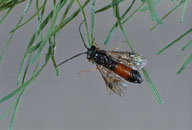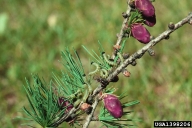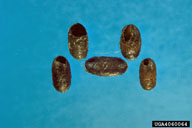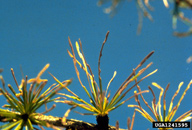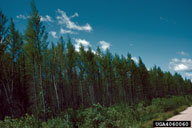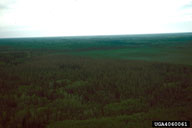Larch sawfly
Pristiphora erichsonii (Hartig) (Hymenoptera: Tenthridinidae)
Orientation to pest
Larch sawfly, Pristiphora erichsonii (Hartig), was historically a serious pest of larch (Larix) in North America. It is present throughout Canada, Alaska, most of the northern tier of US states. Distinct strains of the species have been recognized, with different geographical origins. A debate has existed over whether strains of this species found in North American before 1920 were native to North America or were invasive from Europe at an earlier date. Further complicating matters is the accidental introduction of additional strains, definitely from Europe that occurred during a biological control program (1910-1930) against the species that released cocoons (both parasitized and unparasitized) collected in Europe in the field in Canada. This sawfly overwinters as prepupae in cocoons in the duff. Adults emerge in spring and lay eggs in new shoots, causing curling. All larch sawfly adults are females. Newly hatched larvae feed in groups, mainly on the needle clusters of older twigs. Dense populations can defoliate whole trees. Mature larvae drop to the ground to spin cocoons. There is one generation per year in most locations, but some individuals may remain in their cocoons for two or three winters before emerging. Damaging outbreaks have occurred periodically. During outbreaks, trees are not commonly killed, but wood growth is reduced. Weakened surviving trees may also be at increased risk of bark beetle attack.
Hosts commonly attacked
Larch sawfly feeds on eastern larch (Larix laricina [Du Roi] K. Koch), western larch (Larix occidentalis Nutthal), and alpine larch (Larix lyallii Parl.).
Distribution
Larch sawfly occurs in all Canadian provinces, Alaska, all the northern tier of U.S. states, as well as Maryland, North Carolina, and West Virginia.
Images of larch sawfly
| Figure 1. Adult of larch sawfly, Pristiphora erichsonii | Figure 2. Larvae of larch sawfly | Figure 3. Cocoons of larch sawfly, showing adult emergence holes |
| Figure 4. Larch needles showing feeding by larch sawfly larvae | Figure 5. A larch stand in Minnesota showing partial (50%) defoliation caused by larch sawfly | Figure 6. Landscape level defoliation of larch in Minnesota in 1953 caused by larch |
Important biological control agents related to this pest species
The history of biological control efforts against larch sawfly in North America is complex. See Van Driesche et al. (1996) for a detailed history. Natural enemies in North America that are important to the population dynamics of larch sawfly include a tachinid (Bessa harveyi [Townsend]), a guild of native small mammals, and two introduced ichneumonid parasitoids, Mesoleius tenthredinis Morely and Olesicampe benefactor Hinz. An important factor mediating outcomes in early stages of the biological control program was variation in the ability of the several sawfly strains to encapsulate the eggs of the parasitoid M. tenthredinis. This was subsequently resolved by introduction of a second strain that was able to resist encapsulation.
Web links for information on larch sawfly
Articles
- Turnock, W. J. 1960. Ecological life-history of the larch sawfly, Pristiphora erichsonii (Htg.) (Hymenoptera: Tenthredinidae), in Manitoba and Saskatchewan. The Canadian Entomologist 92: 500-516.
- Hu, F. 1964. Population dynamics of the larch sawfly. The Canadian Entomologist 96: 160-161.
- Turnock, W. J. 1972. Geographical and historical variability in population patterns and life systems of the larch sawfly (Hymenoptera: Tenthredinidae). The Canadian Entomologist 104: 1883-1900.
- Wong, H. R. 1974. The identification and origin of the strains of the larch sawfly, Pristiphora erichsonii (Hymenoptera: Tenthredinidae), in North America. The Canadian Entomologist 106: 1121-1131.
- Maltais, P. P., J. J. Juillet, and D. D. de Oliveira. 1980. Ecology and population dynamics of the larch sawfly, Pristiphora erichsonii (Htg.) in Kouchibouguac National Park, New Brunswick. Annals of the Entomological Society of Quebec 25: 141-162.
- Krause, S. L. and K. F. Raffa. 1996. Defoliation tolerance affects the spatial and temporal distributions of larch sawfly and natural enemy populations. Ecological Entomology 21: 101-111.
- Van Driesche, R.G., S. Healy, and R. C. Reardon. 1996. Biological Control of Arthropod Pests of the Northeastern and North Central Forests in the United States: A review and recommendation. FHTET 96-19, December 1996, USDA Forest Service, Morgantown, see: http://www.forestpestbiocontrol.info/fact_sheets/documents/arthropodpestsnortheastern_northcentral.pdf
